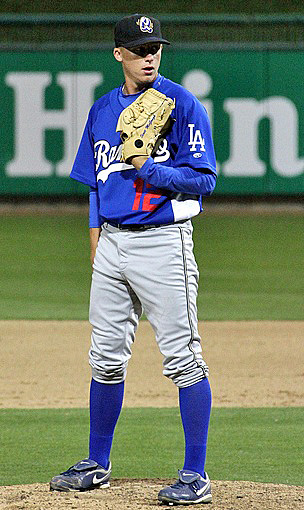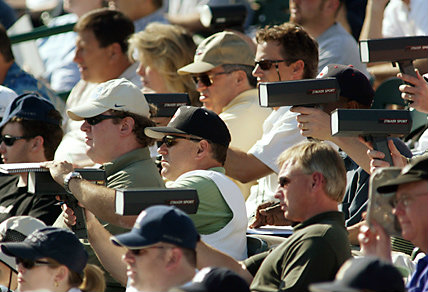When you stop and think about the millions of kids (and I literally mean millions) who participate in organized baseball from T-Ball through Little League through high school and college, and then you consider that there are a total… total of 750 guys who actually play Major League Baseball, you begin to realize just how extremely talented and gifted these 750 guys really are (well… maybe except for Juan Uribe). I mean, the odds of a Little Leaguer actually making it to the Bigs is a fraction of a fraction of a percent; something to consider the next time you start complaining about how much money MLB players make (as compared to the amount of money made by the hundreds of thousands of movie, stage and television actors or others in the entertainment industry). Yet in spite of these seemingly insurmountable odds, these millions of kids continue to play the game, each with the hope and dream of someday becoming one of these rare 750 MLB players. But these 750 guys weren’t (and aren’t) just plucked out of the sky; every single one of them had to pay their dues and earn their way onto one of the 30 MLB rosters through Minor League Baseball (MiLB).

Quakes reliever Scott McGough was the first Dodger prospect to be traded before the July 31 MLB Trade Deadline. Who will be next? (Photo credit – FeelinKindaBlue.com)
If it weren’t for MLB’s annual July 31 non-waiver trade deadline, many casual or occasional followers of the game wouldn’t even know that the MiLB existed and the word “prospect” would mean nothing to them (except, perhaps, as one who pans for gold). But at this time of year, every year, even they can’t avoid hearing or reading about the trade deadline or MiLB prospects.
For those of us who follow baseball closely, even passionately (and you probably wouldn’t be reading this if you didn’t), the MiLB is almost second nature to us; we understand that MiLB is broken down into several different levels – levels that are divided by skill and (in some cases) by age. But for those who might not be as familiar with how it all works, allow me to explain.
Outstanding high school and college baseball players are scouted by… scouts (usually former players, coaches or others somehow connected to the game) who are paid to do exactly that. These scouts report their observations back to their respective team’s player development people who, in turn, compile a priority list of who they wish to draft at the annual June MLB First-Year Player Draft. Once a player is drafted, they have until July 15 (July 13 this year because the 15th fell on a Sunday) to decide to sign with the team that drafted them or not. If they do not sign and instead choose to return to school, they cannot be drafted by that same team again in subsequent drafts unless they consent to do so. Once signed, the drafted player is assigned to one of the team’s MiLB affiliates. Most first-year drafted players are assigned to their respective team’s Rookie League but it is not uncommon for players drafted out of college to go straight to Single-A. The Dodgers MiLB affiliates are:
Rookie League
Arizona League – Arizona Dodgers – Glendale, Arizona.
Pioneer League – Ogden Raptors – Ogden, Utah.
Dominican Summer League – Dominican Summer League Dodgers – Campo Las Palmas – Guerra, Dominican Republic.
Single-A (Low-A) – Midwest League – Great Lakes Loons – Midland, Michigan.
Advance Single-A (High-A) – California League – Rancho Cucamonga Quakes – Rancho Cucamonga, California.
Double-A – Southern League – Chattanooga Lookouts – Chattanooga, Tennessee.
Triple-A – Pacific Coast League – Albuquerque Isotopes – Albuquerque, New Mexico.
It is from these rosters (excluding the Dominican Summer League Dodgers) where Dodger prospects come from that are used as bargaining chips in trades made prior to MLB’s July 31 Trade Deadline. I can assure you that every Dodger MiLB player has been scouted by every other MLB team (the scouts are easy to spot – they usually sit directly behind home plate, have a notebook on their lap, a radar gun in one hand, and a cell phone in the other – no joke).
Although the Dodgers have historically had a great Minor League system, one which many other MLB teams modeled their own after, the Dodgers MiLB system was basically ignored by former owners News Corps and more recently by Frank McCourt. As a result, the once great Dodgers farm system has fallen by the wayside and the Dodgers now have very few prospects (aside from a few top pitching prospects who they would be ill-advised to trade away) to use as bargaining chips to try to acquire quality players for the stretch run. Fortunately, what the Dodgers do have is a new owner group that is willing to spend the money to absorb current (and insanely expensive) existing contracts of some of the game’s best players. And while teams that are out of contention (sellers) would prefer top prospects in exchange for their best players to rebuild their system, they are unlikely to turn a blind eye to someone (say… like… the Dodgers) who are willing to relieve them of huge salary obligations, thus allowing them to acquire free agents to fulfill specific needs of their own. As a result of this, there is little doubt that the Dodgers are not finished just yet in going after some of the biggest names in the game prior to Tuesday’s trading deadline.
Stay tuned…
Authors note: Wikipedia has an excellent posting on Minor League Baseball that covers its entire history.




 July 29th, 2012 at 10:59 am
July 29th, 2012 at 10:59 am  by Ron Cervenka
by Ron Cervenka 
 Posted in
Posted in 

I thought that the big stuff would happen on Monday – Looks like it’s going to go down to the wire.
As you know, I am as fixed on minor league baseball, Dodger minor league baseball, as I am on MLB, Dodger MLB. Somehow I can feel what the kids are going through as they tackle a task as daunting as climbing Mt. Everest. If as many young people tackled Mt. Everest as tackle the world of baseball, there is little doubt many more would succeed in climbing Everest than make it to MLB.
It is an almost impossible task to become a major leaguer. The young player is competing against so many others, injuries slow down or derail careers, players get backed up behind major leaguers who play several years for a team, they go unnoticed, their skill set is underestimated or doesn’t meet a need at MLB level at a given time, players get picked up at the trade deadline that puts the youngsters further down the depth chart, teams are so intent on winning now that they can’t wait for young players to mature. That is one long sentence, and I am sure it could be longer.
I love the minor leagues, and yes, I get very attached to the kids trying so hard to fulfill their dream of becoming a major league baseball player. Perhaps that is because it was my dream as a kid, and still is.
Great point about the $$$$$$$ paid to MLB players Ron. Yes, some are overpaid compared to others, but where doesn’t that happen in life? Your point is a good one regarding $$$$$$$$ in the entertainment business. Try comparing hitting a speeding bullet, a baseball, with preparing some lines for a scene in a movie with stunt men to do the dirty work for you.